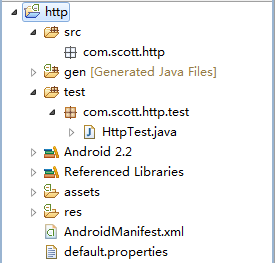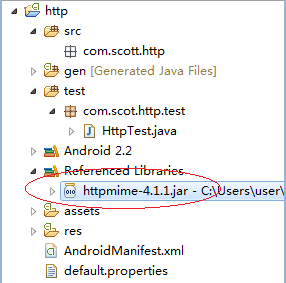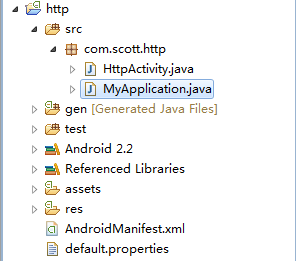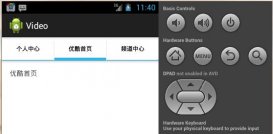本文实例讲述了android编程中http服务用法。分享给大家供大家参考,具体如下:
在android中,除了使用java.net包下的api访问http服务之外,我们还可以换一种途径去完成工作。android sdk附带了apache的httpclient api。apache httpclient是一个完善的http客户端,它提供了对http协议的全面支持,可以使用http get和post进行访问。下面我们就结合实例,介绍一下httpclient的使用方法。
我们新建一个http项目,项目结构如图:

在这个项目中,我们不需要任何的activity,所有的操作都在单元测试类httptest.java中完成。
因为使用到了单元测试,所以在这里先介绍一下如何配置android中的单元测试。所有配置信息均在androidmanifest.xml中完成:
|
1
2
3
4
5
6
7
8
9
10
11
12
13
14
15
16
|
<?xml version="1.0" encoding="utf-8"?><manifest xmlns:android="http://schemas.android.com/apk/res/android" package="com.scott.http" android:versioncode="1" android:versionname="1.0"> <application android:icon="@drawable/icon" android:label="@string/app_name"> <!-- 配置测试要使用的类库 --> <uses-library android:name="android.test.runner"/> </application> <!-- 配置测试设备的主类和目标包 --> <instrumentation android:name="android.test.instrumentationtestrunner" android:targetpackage="com.scott.http"/> <!-- 访问http服务所需的网络权限 --> <uses-permission android:name="android.permission.internet"/> <uses-sdk android:minsdkversion="8" /></manifest> |
然后,我们的单元测试类需要继承android.test.androidtestcase类,这个类本身是继承junit.framework.testcase,并提供了getcontext()方法,用于获取android上下文环境,这个设计非常有用,因为很多android api都是需要context才能完成的。
现在让我们来看一下我们的测试用例,httptest.java代码如下:
|
1
2
3
4
5
6
7
8
9
10
11
12
13
14
15
16
17
18
19
20
21
22
23
24
25
26
27
28
29
30
31
32
33
34
35
36
37
38
39
40
41
42
43
44
45
46
47
48
49
50
51
52
53
54
55
56
57
58
59
60
61
62
63
64
65
66
67
68
69
70
71
72
73
74
75
|
package com.scot.http.test;import java.io.bytearrayoutputstream;import java.io.inputstream;import java.util.arraylist;import java.util.list;import junit.framework.assert;import org.apache.http.httpentity;import org.apache.http.httpresponse;import org.apache.http.httpstatus;import org.apache.http.namevaluepair;import org.apache.http.client.httpclient;import org.apache.http.client.entity.urlencodedformentity;import org.apache.http.client.methods.httpget;import org.apache.http.client.methods.httppost;import org.apache.http.entity.mime.multipartentity;import org.apache.http.entity.mime.content.inputstreambody;import org.apache.http.entity.mime.content.stringbody;import org.apache.http.impl.client.defaulthttpclient;import org.apache.http.message.basicnamevaluepair;import android.test.androidtestcase;public class httptest extends androidtestcase { private static final string path = "http://192.168.1.57:8080/web"; public void testget() throws exception { httpclient client = new defaulthttpclient(); httpget get = new httpget(path + "/testservlet?id=1001&name=john&age=60"); httpresponse response = client.execute(get); if (response.getstatusline().getstatuscode() == httpstatus.sc_ok) { inputstream is = response.getentity().getcontent(); string result = instream2string(is); assert.assertequals(result, "get_success"); } } public void testpost() throws exception { httpclient client = new defaulthttpclient(); httppost post = new httppost(path + "/testservlet"); list<namevaluepair> params = new arraylist<namevaluepair>(); params.add(new basicnamevaluepair("id", "1001")); params.add(new basicnamevaluepair("name", "john")); params.add(new basicnamevaluepair("age", "60")); httpentity formentity = new urlencodedformentity(params); post.setentity(formentity); httpresponse response = client.execute(post); if (response.getstatusline().getstatuscode() == httpstatus.sc_ok) { inputstream is = response.getentity().getcontent(); string result = instream2string(is); assert.assertequals(result, "post_success"); } } public void testupload() throws exception { inputstream is = getcontext().getassets().open("books.xml"); httpclient client = new defaulthttpclient(); httppost post = new httppost(path + "/uploadservlet"); inputstreambody isb = new inputstreambody(is, "books.xml"); multipartentity multipartentity = new multipartentity(); multipartentity.addpart("file", isb); multipartentity.addpart("desc", new stringbody("this is description.")); post.setentity(multipartentity); httpresponse response = client.execute(post); if (response.getstatusline().getstatuscode() == httpstatus.sc_ok) { is = response.getentity().getcontent(); string result = instream2string(is); assert.assertequals(result, "upload_success"); } } //将输入流转换成字符串 private string instream2string(inputstream is) throws exception { bytearrayoutputstream baos = new bytearrayoutputstream(); byte[] buf = new byte[1024]; int len = -1; while ((len = is.read(buf)) != -1) { baos.write(buf, 0, len); } return new string(baos.tobytearray()); }} |
因为此文件包含三个测试用例,所以我将会逐个介绍一下。
首先,需要注意的是,我们定位服务器地址时使用到了ip,因为这里不能用localhost,服务端是在windows上运行,而本单元测试运行在android平台,如果使用localhost就意味着在android内部去访问服务,可能是访问不到的,所以必须用ip来定位服务。
我们先来分析一下testget测试用例。我们使用了httpget,请求参数直接附在url后面,然后由httpclient执行get请求,如果响应成功的话,取得响应内如输入流,并转换成字符串,最后判断是否为get_success。
testget测试对应服务端servlet代码如下:
|
1
2
3
4
5
6
7
8
9
|
@override protected void doget(httpservletrequest request, httpservletresponse response) throws servletexception, ioexception { system.out.println("doget method is called."); string id = request.getparameter("id"); string name = request.getparameter("name"); string age = request.getparameter("age"); system.out.println("id:" + id + ", name:" + name + ", age:" + age); response.getwriter().write("get_success"); } |
然后再说testpost测试用例。我们使用了httppost,url后面并没有附带参数信息,参数信息被包装成一个由namevaluepair类型组成的集合的形式,然后经过urlencodedformentity处理后调用httppost的setentity方法进行参数设置,最后由httpclient执行。
testpost测试对应的服务端代码如下:
|
1
2
3
4
5
6
7
8
9
|
@override protected void dopost(httpservletrequest request, httpservletresponse response) throws servletexception, ioexception { system.out.println("dopost method is called."); string id = request.getparameter("id"); string name = request.getparameter("name"); string age = request.getparameter("age"); system.out.println("id:" + id + ", name:" + name + ", age:" + age); response.getwriter().write("post_success"); } |
上面两个是最基本的get请求和post请求,参数都是文本数据类型,能满足普通的需求,不过在有的场合例如我们要用到上传文件的时候,就不能使用基本的get请求和post请求了,我们要使用多部件的post请求。下面介绍一下如何使用多部件post操作上传一个文件到服务端。
由于android附带的httpclient版本暂不支持多部件post请求,所以我们需要用到一个httpmime开源项目,该组件是专门处理与mime类型有关的操作。因为httpmime是包含在httpcomponents 项目中的,所以我们需要去apache官方网站下载httpcomponents,然后把其中的httpmime.jar包放到项目中去,如图:

然后,我们观察testupload测试用例,我们用httpmime提供的inputstreambody处理文件流参数,用stringbody处理普通文本参数,最后把所有类型参数都加入到一个multipartentity的实例中,并将这个multipartentity设置为此次post请求的参数实体,然后执行post请求。服务端servlet代码如下:
|
1
2
3
4
5
6
7
8
9
10
11
12
13
14
15
16
17
18
19
20
21
22
23
24
25
26
27
28
29
30
31
32
33
34
35
36
37
38
39
40
41
42
43
44
45
46
47
48
49
50
|
package com.scott.web.servlet;import java.io.fileoutputstream;import java.io.ioexception;import java.util.iterator;import java.util.list;import javax.servlet.servletexception;import javax.servlet.http.httpservlet;import javax.servlet.http.httpservletrequest;import javax.servlet.http.httpservletresponse;import org.apache.commons.fileupload.fileitem;import org.apache.commons.fileupload.fileitemfactory;import org.apache.commons.fileupload.fileuploadexception;import org.apache.commons.fileupload.disk.diskfileitemfactory;import org.apache.commons.fileupload.servlet.servletfileupload;@suppresswarnings("serial")public class uploadservlet extends httpservlet { @override @suppresswarnings("rawtypes") protected void dopost(httpservletrequest request, httpservletresponse response) throws servletexception, ioexception { boolean ismultipart = servletfileupload.ismultipartcontent(request); if (ismultipart) { fileitemfactory factory = new diskfileitemfactory(); servletfileupload upload = new servletfileupload(factory); try { list items = upload.parserequest(request); iterator iter = items.iterator(); while (iter.hasnext()) { fileitem item = (fileitem) iter.next(); if (item.isformfield()) { //普通文本信息处理 string paramname = item.getfieldname(); string paramvalue = item.getstring(); system.out.println(paramname + ":" + paramvalue); } else { //上传文件信息处理 string filename = item.getname(); byte[] data = item.get(); string filepath = getservletcontext().getrealpath("/files") + "/" + filename; fileoutputstream fos = new fileoutputstream(filepath); fos.write(data); fos.close(); } } } catch (fileuploadexception e) { e.printstacktrace(); } } response.getwriter().write("upload_success"); }} |
服务端使用apache开源项目fileupload进行处理,所以我们需要commons-fileupload和commons-io这两个项目的jar包,对服务端开发不太熟悉的朋友可以到网上查找一下相关资料。
介绍完上面的三种不同的情况之后,我们需要考虑一个问题,在实际应用中,我们不能每次都新建httpclient,而是应该只为整个应用创建一个httpclient,并将其用于所有http通信。此外,还应该注意在通过一个httpclient同时发出多个请求时可能发生的多线程问题。针对这两个问题,我们需要改进一下我们的项目:
1.扩展系统默认的application,并应用在项目中。
2.使用httpclient类库提供的threadsafeclientmanager来创建和管理httpclient。
改进后的项目结构如图:

其中myapplication扩展了系统的application,代码如下:
|
1
2
3
4
5
6
7
8
9
10
11
12
13
14
15
16
17
18
19
20
21
22
23
24
25
26
27
28
29
30
31
32
33
34
35
36
37
38
39
40
41
42
43
44
45
46
47
48
49
50
51
52
53
54
55
|
package com.scott.http;import org.apache.http.httpversion;import org.apache.http.client.httpclient;import org.apache.http.conn.clientconnectionmanager;import org.apache.http.conn.scheme.plainsocketfactory;import org.apache.http.conn.scheme.scheme;import org.apache.http.conn.scheme.schemeregistry;import org.apache.http.conn.ssl.sslsocketfactory;import org.apache.http.impl.client.defaulthttpclient;import org.apache.http.impl.conn.tsccm.threadsafeclientconnmanager;import org.apache.http.params.basichttpparams;import org.apache.http.params.httpparams;import org.apache.http.params.httpprotocolparams;import org.apache.http.protocol.http;import android.app.application;public class myapplication extends application { private httpclient httpclient; @override public void oncreate() { super.oncreate(); httpclient = this.createhttpclient(); } @override public void onlowmemory() { super.onlowmemory(); this.shutdownhttpclient(); } @override public void onterminate() { super.onterminate(); this.shutdownhttpclient(); } //创建httpclient实例 private httpclient createhttpclient() { httpparams params = new basichttpparams(); httpprotocolparams.setversion(params, httpversion.http_1_1); httpprotocolparams.setcontentcharset(params, http.default_content_charset); httpprotocolparams.setuseexpectcontinue(params, true); schemeregistry schreg = new schemeregistry(); schreg.register(new scheme("http", plainsocketfactory.getsocketfactory(), 80)); schreg.register(new scheme("https", sslsocketfactory.getsocketfactory(), 443)); clientconnectionmanager connmgr = new threadsafeclientconnmanager(params, schreg); return new defaulthttpclient(connmgr, params); } //关闭连接管理器并释放资源 private void shutdownhttpclient() { if (httpclient != null && httpclient.getconnectionmanager() != null) { httpclient.getconnectionmanager().shutdown(); } } //对外提供httpclient实例 public httpclient gethttpclient() { return httpclient; }} |
我们重写了oncreate()方法,在系统启动时就创建一个httpclient;重写了onlowmemory()和onterminate()方法,在内存不足和应用结束时关闭连接,释放资源。需要注意的是,当实例化defaulthttpclient时,传入一个由threadsafeclientconnmanager创建的一个clientconnectionmanager实例,负责管理httpclient的http连接。
然后,想要让我们这个加强版的“application”生效,需要在androidmanifest.xml中做如下配置:
|
1
2
3
|
<application android:name=".myapplication" ...>...</application> |
如果我们没有配置,系统默认会使用android.app.application,我们添加了配置,系统就会使用我们的com.scott.http.myapplication,然后就可以在context中调用getapplication()来获取myapplication实例。
有了上面的配置,我们就可以在活动中应用了,httpactivity.java代码如下:
|
1
2
3
4
5
6
7
8
9
10
11
12
13
14
15
16
17
18
19
20
21
22
23
24
25
26
27
28
29
30
31
32
33
34
35
36
37
38
39
40
41
42
43
44
45
46
47
48
49
50
51
|
package com.scott.http;import java.io.bytearrayoutputstream;import java.io.inputstream;import org.apache.http.httpresponse;import org.apache.http.httpstatus;import org.apache.http.client.httpclient;import org.apache.http.client.methods.httpget;import android.app.activity;import android.os.bundle;import android.view.view;import android.widget.button;import android.widget.toast;public class httpactivity extends activity { @override protected void oncreate(bundle savedinstancestate) { super.oncreate(savedinstancestate); setcontentview(r.layout.main); button btn = (button) findviewbyid(r.id.btn); btn.setonclicklistener(new view.onclicklistener() { @override public void onclick(view v) { execute(); } }); } private void execute() { try { myapplication app = (myapplication) this.getapplication(); //获取myapplication实例 httpclient client = app.gethttpclient(); //获取httpclient实例 httpget get = new httpget("http://192.168.1.57:8080/web/testservlet?id=1001&name=john&age=60"); httpresponse response = client.execute(get); if (response.getstatusline().getstatuscode() == httpstatus.sc_ok) { inputstream is = response.getentity().getcontent(); string result = instream2string(is); toast.maketext(this, result, toast.length_long).show(); } } catch (exception e) { e.printstacktrace(); } } //将输入流转换成字符串 private string instream2string(inputstream is) throws exception { bytearrayoutputstream baos = new bytearrayoutputstream(); byte[] buf = new byte[1024]; int len = -1; while ((len = is.read(buf)) != -1) { baos.write(buf, 0, len); } return new string(baos.tobytearray()); }} |
点击“execute”按钮,执行结果如下:

希望本文所述对大家android程序设计有所帮助。














